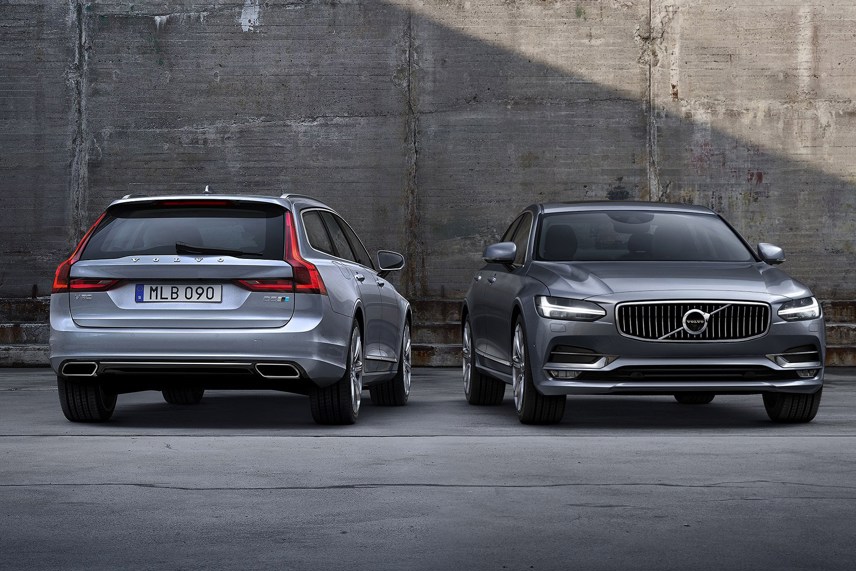Review
Following the success of the XC90 SUV was never going to be a small feat, but the new S90 and V90 could see Volvo’s winning streak continue.
In 2010, Volvo’s acquisition by Chinese multinational Geely followed an uneasy few years for the Swedish manufacturer as it trimmed resources after former owner Ford announced its desire to sell.
Six years later and Volvo’s swagger, if it ever had one, is back.
In 2015, it recorded 43,432 registrations (up 5.8% on the 2014 total) and in the first six months of 2016 it recorded 22,629 (up 7% year-on-year).
At least some of that success is down to the XC90, with 2,853 registered in H1 2016. Starting from £46,850, the SUV yielded high-margin sales for the 55 owners of Volvo’s 102 UK sales sites.
Now, the ‘90’ range has expanded with the S90 saloon and V90 estate as Volvo sets its sights on a target of 60,000 UK registrations by 2020.
Volvo UK’s head of product and pricing, Iain Howat, said: “Five or six years ago, people were writing us off. Now we are a manufacturer on the move and the franchised dealers have a lot to look forward to.”
Available from launch with a choice of 187bhp D4 and 232bhp D5 versions of Volvo’s Drive-E two-litre twin-turbodiesel engines – with front- (D4) or all-wheel-drive (D5) – and Momentum or Inscription specifications, prices for the S90 run from £32,555 -£42,055 and the V90 will cost £34,555-£44,055.
Volvo has projected sales of 5,000 for the pair and, after just 500 registrations in 2015 of the outgoing S80 saloon, Howat said sales would be considered “100% conquest”.
With about 75% of those registrations expected to come from fleet, a T8 hybrid drivetrain will be warmly received early next year. Combining a 316bhp petrol engine and 86bhp electric motor, the hybrid will have CO2 emissions as low as 44g/km.
Howat projected that 45% of S90/V90 sales would be in Momentum specification, 55% Inscription specification with an eventual engine split of 70% D4, 20% D5 and 10% T8 Hybrid.
The D4 engine available from launch claims fuel consumption of 64mpg and 116g/km CO2 emissions in the S90 and 63mpg and 119g/km CO2 in the V90.
The more powerful D5 should deliver 59mpg and 127g/km CO2 in the S90 alongside 58mpg and 129g/km in the V90.
The new S90 and V90 sit on a new Scalable Model Architecture, a platform that allows Volvo to tailor the dimensions on a range of future products.
At 4,963mm, the S90 and V90 are the longest vehicles in their class, but boot space of 500 litres (S90) or 560 (V90) is bettered by the Audi A6, the BMW 5 Series and the Mercedes-Benz E-Class.
Both Volvos score points for their interior accommodation, however, and Volvo justifies that near five-metre length with impressive rear leg room.
Crisp, Swedish interior design mirrors that found in the XC90, and the nine-inch portrait Sensus Connect touchscreen is the most dominant familiar feature in a cabin swathed in leather and other high-quality materials.
Sensus Connect brings access to a range of web apps and connected service booking, enabling the car to pre-book itself into a chosen Volvo dealership.
Satnav and dual-zone climate control are also among the standard equipment.
Outside, the newcomers feature the ‘Thor’s Hammer’ LED headlight design featured on the XC90, with automatic high beam, and an electric boot lid.
As part of Volvo’s ‘2020 vision’ – that no one should be killed or seriously injured in a new Volvo car by 2020 – the S90 and V90 also include a broad range of safety technology.
Pedestrian, cyclist and large animal detection will deploy a front collision warning and fully automatic emergency braking if necessary, while run-off road protection will automatically tighten the front seatbelts should the car inadvertently leave the road. The front seat frames also feature a collapsible section to help prevent spinal injuries.
Meanwhile, Volvo has taken a further step towards autonomous driving with the introduction of Pilot Assist and adaptive cruise control. Together, the systems will maintain the cars’ course within a marked lane at speeds of up to 80mph.
Inscription specification adds Nappa leather; a 12.3-inch TFT instrument cluster, which adapts its style in accordance with a drive select system offering normal, comfort and sport settings; keyless entry and engine starting; and hands-free boot lid opening and closing.
In terms of sheer interior space and comfort, Volvo’s newcomers are standard-setting and the styling of the V90, in particular, gained the favour of various motoring journalists on its recent launch.
Howat said: “Volvo was once the market leader in the D/E estate segment and our hopes are that this is the car that will put us right up there with the most popular premium contenders in the class.
“We had a fairly chequered history with Ford but everyone is delighted about the direction the new cars are taking us.”
Volvo S90/V90 R-Design
Volvo Cars has revealed performance-inspired R-Design models of the new S90 saloon and V90 estate.
While the new models are not scheduled to receive a makeover from Volvo’s performance arm, Polestar, any time soon, R-Design models will feature a sport chassis, unique grille and piano black trim. A new five-spoke
matt black diamond-cut wheel also adds to the performance feel.
Volvo said “sporty contour seats and special steering wheel” would be part of the interior highlights.
Order books are now open for the S90 and V90 R-Design models, with UK delivery dates to be announced in Q3.
Author:
Tom Sharpe
Former news and features editor (left May 2023)
Factsheet
Price £32,555 to £44,055
Engine two-litre, four-cylinder, turbodiesel; 187/232bhp
Performance 0 to 62mph 7/8.5 seconds; top speed 140/149mph
Transmission 8sp automatic
Efficiency 58mpg to 64mpg
RV 3yr/30k 40% to 41%
Rivals Audi A6, BMW 5 Series, Lexus GS, Mercedes-Benz E-Class














